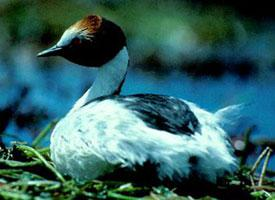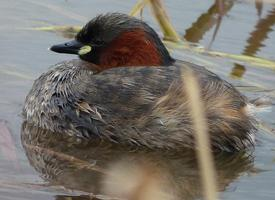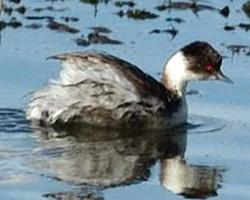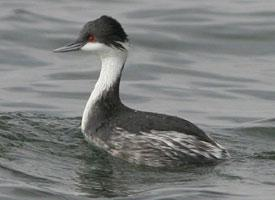
Poids et mesures
| Longueur | 34 cm |
|---|
Statut de conservation
| Menacé |
Description de l'animal
The Hooded Grebe, scientifically named Podiceps gallardoi, is a fascinating and relatively rare bird species that belongs to the grebe family. Discovered in the late 20th century, specifically in 1974, it has since captivated ornithologists and bird enthusiasts alike with its unique characteristics and behavior. This species is endemic to Argentina, primarily found in the remote and pristine landscapes of Patagonia, where it inhabits freshwater lakes and lagoons.One of the most striking features of the Hooded Grebe is its appearance. Adults have a distinctive black-and-white color pattern, with a stunning black hood and throat that contrast sharply against their white cheeks and underparts. Their backs and wings are dark, while the flanks can show a mesmerizing silver-grey hue. During the breeding season, they sport a remarkable rufous "ear" tuft, which adds to their distinctive look. The bird's eyes are notably red, adding a touch of vivid color to its monochrome palette. Juveniles and non-breeding adults have a more subdued appearance, lacking the dramatic contrasts and tufts of their breeding counterparts.
The Hooded Grebe is medium-sized, with a body length typically ranging from 31 to 34 centimeters (12 to 13 inches). They have a compact body, a relatively small head with a pointed bill, and a long neck, which they often hold in an S-shape. Like other grebes, they have lobed toes rather than webbed feet, an adaptation that makes them excellent swimmers and divers but somewhat awkward on land.
Behaviorally, the Hooded Grebe is as interesting as it is in appearance. It breeds in high-altitude lakes and lagoons, often in areas that are difficult to access. Their nests are floating platforms constructed from vegetation, anchored to submerged plants. This species is known for its elaborate courtship displays, which include synchronized dancing and diving sequences that strengthen pair bonds. After mating, both parents are involved in incubating the eggs and rearing the young.
Diet-wise, the Hooded Grebe primarily feeds on small fish and aquatic invertebrates. It catches its prey by diving underwater, using its adept swimming abilities to navigate and chase down food sources.
Despite its beauty and unique behaviors, the Hooded Grebe faces significant threats that have led to its classification as Critically Endangered by the International Union for Conservation of Nature (IUCN). The main threats include habitat destruction due to the construction of dams, predation by introduced species such as the American mink, and the impact of climate change on its freshwater habitats. Conservation efforts are underway to protect this species and its habitat, including predator control and habitat restoration projects, but the Hooded Grebe's future remains uncertain.
In summary, the Hooded Grebe is a remarkable bird with a distinctive appearance and fascinating behaviors, endemic to the remote regions of Patagonia. Despite its allure, it faces critical threats that challenge its survival, making conservation efforts crucial for its continued existence in the wild.
Animaux similaires
Nouvelles photos d'animaux
Top 10 des animaux
- Dolphin gull (Leucophaeus scoresbii)
- Diana monkey (Cercopithecus diana)
- Moustached guenon (Cercopithecus cephus)
- Galápagos tortoise (Geochelone nigra complex)
- Russian tortoise (Testudo horsfieldii)
- Japanese macaque (Macaca fuscata)
- Stone loach (Barbatula barbatula)
- Greek tortoise (Testudo graeca)
- Common flying dragon (Draco volans)
- Colossal squid (Mesonychoteuthis hamiltoni)


